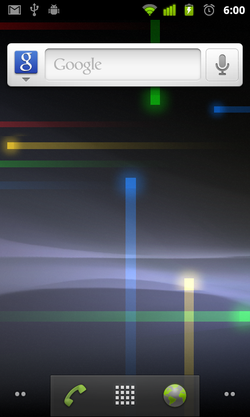Android 2.3 Gingerbreadis the seventh version of Android, a version of theAndroidmobile operating systemdeveloped byGoogleand released in December 2010.
| Version of theAndroidoperating system | |
 | |
 Android 2.3.7 on an Android SDK emulator | |
| Developer | |
|---|---|
| Initial release | December 6, 2010[1] |
| Final release | 2.3.7_r1 (GWK74)[2]/ September 21, 2011 |
| Kerneltype | Monolithic(Linux) |
| Preceded by | Android 2.2.3 "Froyo" |
| Succeeded by | Android 3.0 "Honeycomb"(tablets) Android 4.0 "Ice Cream Sandwich"(smartphones) |
| Official website | developer |
| Support status | |
| Unsupported since November 14, 2016 Google Play Services support dropped since January 2017[3] | |
Version
editThe Gingerbread release introduced support fornear field communication(NFC)—used in mobile payment solutions—andSession Initiation Protocol(SIP)—used inVoIPinternet telephones.[4]The first phone with Android Gingerbread was theNexus S.
Gingerbread's user interface was refined, making it easier to master, faster to use, and more power-efficient. A simplified color scheme with a black background gave vividness and contrast to the notification bar, menus, and other user interface components. Improvements in menus and settings resulted in easier navigation and system control.
TheNexus Ssmartphone, released in December 2010, was the first phone from theGoogle Nexusline that ran Gingerbread, and also the first one from the line with built-in NFC functionality.[5]
As of October 2022[update],statistics issued by Google indicate that 0.11% of all Android devices accessing Google Play were running on Gingerbread.[6]Google ceased sign-in support for Gingerbread on September 27, 2021.[7]
Features
editNew features introduced by Gingerbread include the following:
- Updated user interface design, providing increased ease of use and efficiency.
- Support for extra-large screen sizes and resolutions (WXGAand higher).
- Native support for SIP VoIP internet telephones.
- Improved text input using the virtual keyboard, with improved accuracy, better text suggestions, and voice input capability.
- Enhanced copy/paste functionality, allowing users to select a word by press-holding, copying, and pasting.
- Support for Near Field Communication (NFC), allowing the user to read NFC tags embedded in posters, stickers, or advertisements.
- New audio effects such as reverb, equalization, headphone virtualization, and bass boost.
- New Download Manager, giving users easy access to any file downloaded from the browser,email,or another application.
- Support for multiple cameras on the device, including a front-facing camera, if available.
- Support for WebM/VP8 video playback, andAACaudio encoding.
- Improved power management, including more active management of power-consuming applications.
- Enhanced support for native code development.
- A switch fromYAFFStoext4file system on newer devices.
- Audio, graphical, and input enhancements for game developers.
- Concurrent garbage collection for increased performance.
- Native support for more sensors (such as gyroscopes and barometers).
- The first Android easter egg, which depicts the Android mascot standing beside a zombified gingerbread man in a field of other zombies talking on cell phones, presumably Android smartphones.
- Improved speed overFroyodue to system updates.
See also
editReferences
edit- ^"Android 2.3 Platform and Updated SDK Tools".Archivedfrom the original on May 19, 2021.RetrievedMay 27,2021.
- ^"Android Source".Google Git.Archivedfrom the original on May 27, 2021.RetrievedMay 27,2021.
- ^"Google to drop the support from Android 2.3 (Gingerbread) devices".November 22, 2016.Archivedfrom the original on August 27, 2022.RetrievedAugust 27,2022.
- ^Graham, Flora (December 7, 2010)."What's new in Google's Android 2.3 Gingerbread?".CNET.Archivedfrom the original on August 11, 2018.RetrievedSeptember 3,2015.
- ^Hollister, Sean (November 15, 2010)."The Nexus S: a closer look".Engadget.Archivedfrom the original on April 22, 2019.RetrievedSeptember 3,2015.
- ^"Distribution dashboard".Android Developers.Archivedfrom the original on May 1, 2017.RetrievedMay 14,2019.
- ^Pollack, Zak (July 26, 2021)."Sign-in on Android devices running Android 2.3.7 or lower will not be allowed starting September 27".Google.Archivedfrom the original on April 29, 2022.RetrievedAugust 2,2021.
External links
edit- Media related toAndroid Gingerbreadat Wikimedia Commons
- Official website